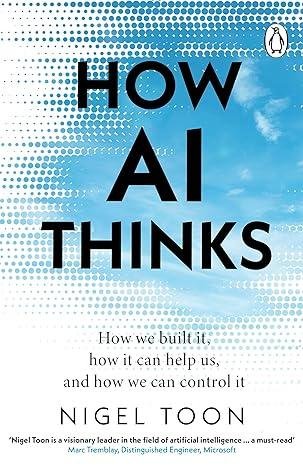Understanding AI: Insights from Nigel Toon's "How AI Thinks"
In the rapidly evolving field of artificial intelligence, understanding how AI systems think and operate has become crucial. Nigel Toon’s book "How AI Thinks" provides an in-depth exploration of AI, delving into its fundamental concepts, innovative applications, and future potential. Available in ePub format, this book offers a comprehensive guide for anyone interested in the world of AI. This article will summarize the key insights from Toon's work, highlighting the major themes and contributions to the field of AI.
The Foundations of AI
Toon begins his book by outlining the historical development of AI. He traces the origins of AI research back to the early 20th century, mentioning pioneers like Alan Turing and John McCarthy. These early visionaries laid the groundwork for what would become a revolutionary field, emphasizing the importance of machine learning and neural networks.
The book discusses the evolution of AI from symbolic AI, which focuses on high-level human-like reasoning, to more contemporary approaches such as machine learning and deep learning. Symbolic AI, which dominated the early stages of AI research, is described in detail, highlighting its strengths in areas such as rule-based systems and logical reasoning.
Machine Learning and Neural Networks
A significant portion of Toon's book is dedicated to explaining machine learning and neural networks. Toon describes machine learning as a method of data analysis that automates analytical model building. It is a branch of AI based on the idea that systems can learn from data, identify patterns, and make decisions with minimal human intervention.
Neural networks, inspired by the human brain, are detailed extensively. Toon explains how these networks consist of layers of interconnected nodes, or neurons, that work together to process information. He explores different types of neural networks, including feedforward neural networks, convolutional neural networks (CNNs), and recurrent neural networks (RNNs), each suited to different types of tasks.
Deep Learning and Its Applications
Deep learning, a subset of machine learning, receives special attention in the book. Toon discusses how deep learning models, particularly deep neural networks, have transformed fields such as image and speech recognition, natural language processing, and autonomous driving.
One of the key strengths of deep learning, as Toon points out, is its ability to automatically discover the representations needed for feature detection or classification from raw data. This has enabled significant advancements in technology, from facial recognition systems to voice-activated assistants like Siri and Alexa.
The Role of Data
Data is at the heart of AI, and Toon emphasizes its importance throughout his book. He discusses how large datasets fuel the training of machine learning models, enabling them to achieve high accuracy and performance. The availability of vast amounts of data has been a driving force behind recent AI breakthroughs.
Toon also addresses the challenges associated with data, such as privacy concerns, data quality, and the need for proper data management. He stresses the importance of ethical considerations in handling data, ensuring that AI systems are transparent, fair, and accountable.
AI in the Real World
Toon provides numerous examples of how AI is being applied in various industries. From healthcare and finance to transportation and entertainment, AI is transforming the way we live and work. Toon describes how AI-powered systems are improving medical diagnostics, enhancing customer experiences, and optimizing supply chains.
In healthcare, for instance, AI algorithms are being used to analyze medical images, predict patient outcomes, and personalize treatment plans. In finance, AI is helping to detect fraudulent transactions, manage risk, and provide personalized financial advice.
Ethical and Societal Implications
The ethical and societal implications of AI are a major theme in Toon's book. He discusses the potential risks associated with AI, such as job displacement, privacy invasion, and the possibility of biased decision-making. Toon advocates for the responsible development and deployment of AI technologies, emphasizing the need for ethical guidelines and regulatory frameworks.
He also explores the concept of AI ethics, which involves ensuring that AI systems operate in a manner that is fair, transparent, and accountable. Toon argues that as AI becomes more integrated into our lives, it is essential to address these ethical considerations to build trust and ensure the benefits of AI are widely shared.
The Future of AI
Looking ahead, Toon offers his vision for the future of AI. He predicts that AI will continue to advance rapidly, with significant breakthroughs in areas such as quantum computing, neuromorphic engineering, and general AI. Toon is optimistic about the potential of AI to solve complex global challenges, from climate change to disease eradication.
However, he also cautions that the future of AI will depend on how we address the current challenges and ethical considerations. Toon calls for a collaborative approach, involving researchers, policymakers, industry leaders, and the public, to ensure that AI develops in a way that is beneficial for all.
Nigel Toon’s "How AI Thinks" is an essential read for anyone interested in the field of artificial intelligence. Through clear explanations and engaging examples, Toon demystifies the complexities of AI, providing valuable insights into its history, current applications, and future potential. The ePub format makes it accessible and convenient for readers to explore these ideas at their own pace.
As AI continues to evolve, understanding how it works and its impact on society will be crucial. Toon's book serves as a comprehensive guide, helping readers navigate the fascinating world of AI and its implications for the future. Whether you are a student, a professional, or simply curious about AI, "How AI Thinks" offers a wealth of knowledge and perspectives to enrich your understanding of this transformative technology.
